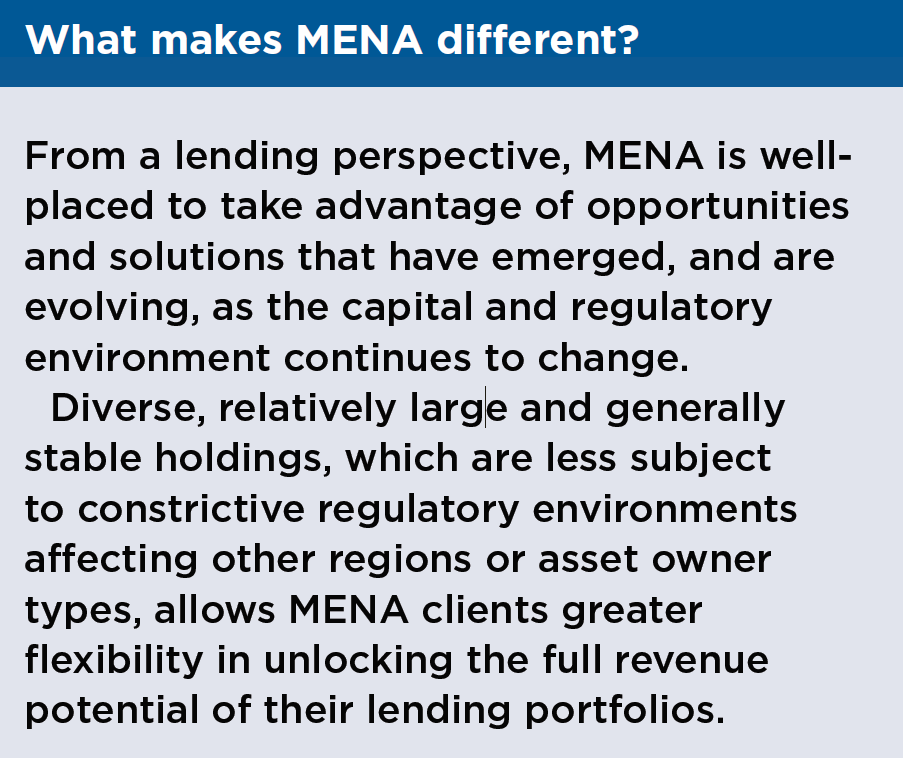JP Morgan: Securities lending growth across the Middle East and North Africa

By Dan Rudd, executive director, JP Morgan
Sustained growth in the Middle East and North Africa (MENA) continues to fuel the need for additional capital and financing. In addition to traditional funding sources, securities lending programmes provide an important option for realizing additional revenues on existing portfolios. As a result, we have seen an increase in lending, in scope and activity, across the region.
In some ways, this is not surprising: for decades, institutions in MENA have been committed to lending programmes. Nearly 20 years ago, for example, a MENA sovereign wealth fund was our first client to create a non-custody lending arrangement. More recently, during the global financial crisis, MENA institutions remained steadfast lenders, providing much needed stability and supply to the market.
Today, as lending markets continue to evolve, new opportunities are welcomed by the diverse types of clients and tailored lending programmes in the region. The need to support regional transformation initiatives, while managing within capital reform changes affecting cost, financing and leverage, are driving institutions to find ways to identify additional revenue. This is where new lending options, in combination with more traditional financing tools, may be able to help.
Five lending options to consider:
Collateral flexibility: In a market with more supply than demand, making your portfolio attractive as possible to borrow is imperative. Cash collateral trades, which are held on balance sheet, have recently fallen in demand due to a lack of borrower balance sheet capacity. However, having the option to accept cash, particularly in markets such as the United States, is extremely important and there are other good trading opportunities in a positive yield curve environment.
Equities remain the collateral of choice on the non-cash side, and those options continue to evolve. For example, to help our clients generate more revenue, we recently expanded our indemnified offering to include ETFs.
Term trades: Borrowers have demand for stable balances, typically of high quality liquid assets to help satisfy “Liquidity Coverage Ratios” and other regulatory requirements such as “Net Stable Funding Ratios”. A premium can be extracted from utilising term, sometimes by as much as 100%.
For term trades, a common preconception is that a client has to ‘lock up’ their individual securities for a set period in a term trade. This is generally not the case. The more common evergreen structures are traded on an asset class basis, so if you have a stable balance of a particular asset class (e.g. U.S. Treasuries), a certain percentage of that asset class can be traded under a term structure allowing the fund manager to sell at any point in time should they wish, with a similar security substituted into the loan. As clients seek to grow revenue, we see more and more interest in this trade structure across the region. The typical term is 95 days, although we see demand for tenures from 35 days.
Pledge: As borrowers pursue balance sheet and capital-friendly products, accepting securities collateral on a pledge basis (as opposed to doing so on a title transfer), is being implemented for U.K. and international borrowers. MENA clients will benefit from the change since the ability to accept collateral Under a pledge arrangement is not available in all jurisdictions.
Agency prime: Agency prime allows lending directly to hedge funds, instead of lending through a prime broker (as borrower) to hedge funds. The prime broker will arrange transactions between the hedge funds (as borrower) and lenders within the agent lending programme. While this is in its infancy, the potential for capital savings indicate that it will likely be another good source of demand for the client base.
Peer to peer: Although there can be many forms of peer to peer structures, depending on the participants’ motivation, the ability to offer a solution to help source liquidity or financing through the use of agent lending platforms is a natural expansion to meet demand. As banks and broker dealers rethink short-term financing and liquidity due to capital and/or regulatory requirements, they are being driven to longer term financing.
No conversation about lending would be complete without a word on indemnification. While lending agents are not removing the indemnity they provide if a borrower fails to return loaned securities when due, there are opportunities for particular trade structures to extract preferential fee splits should such indemnities be removed. The option for this to be at an individual loan, market, collateral and/or borrower level make it a worthwhile conversation to have with your lending agent. While MENA clients do not typically take full advantage of dynamic fee splits, the popularity of these arrangements is growing; in EMEA, for example, one-third of our client base has already adopted this model.
Given the complexity and opportunities within the lending markets, conversations about indemnification are just one of the many options and considerations for clients to evaluate. That’s why we believe that a close partnership and open communication between a client and the lending agent is the most important component of a securities lending programme. As you look for ways to add value through lending, your agent lender should be able to consult, educate and help you explore the various nuances available for your particular programme in today’s market, and keep you informed of these evolving opportunities.
Put our experience to work. For more information, contact Dan Rudd at dan.rudd@jpmorgan.com.
Found this useful?
Take a complimentary trial of the FOW Marketing Intelligence Platform – the comprehensive source of news and analysis across the buy- and sell- side.
Gain access to:
- A single source of in-depth news, insight and analysis across Asset Management, Securities Finance, Custody, Fund Services and Derivatives
- Our interactive database, optimized to enable you to summarise data and build graphs outlining market activity
- Exclusive whitepapers, supplements and industry analysis curated and published by Futures & Options World
- Breaking news, daily and weekly alerts on the markets most relevant to you





